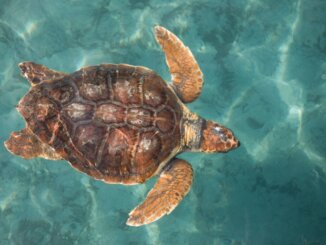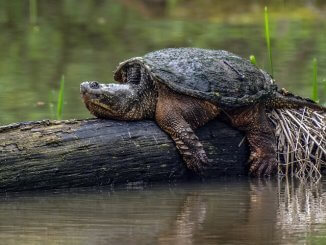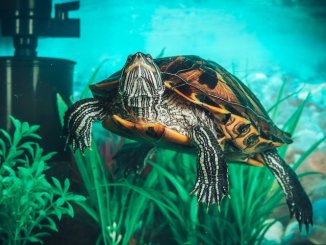A red eared slider is a fun, unique, and interesting pet. They are one of the most popular pet turtles in the world.
Baby red eared sliders are one of the cutest reptiles, it is tempting to get one as a pet. But before you do, take time to consider the care and feeding needs of these tiny turtles. Hatchlings start life no bigger than the size of a quarter!
It is possible to buy this turtle species in the United States. But, selling and buying turtles under four inches long is illegal.
If you have your heart set on a baby red eared slider, continue reading. We discuss the best feeding and husbandry tips for raising a healthy, happy turtle. We also share how to spot a good breeder and where to find one…
1. Buyer’s Guide
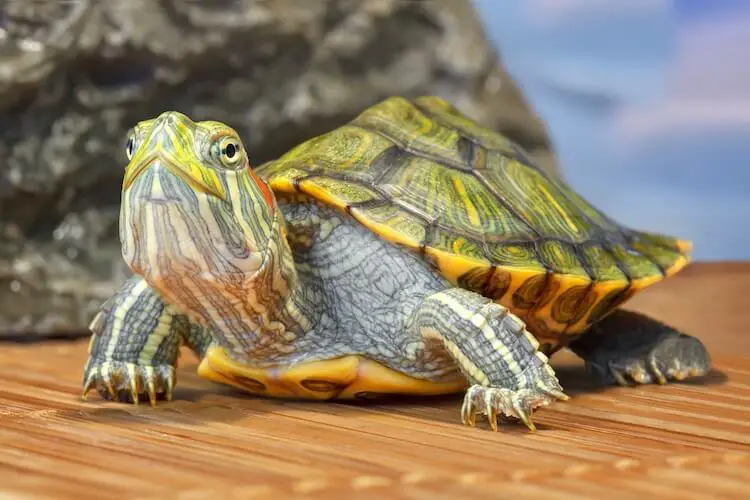
Baby Red Eared Sliders can be found for sale at many reptile expos or from private breeders online.
We do not recommend taking a baby slider from the wild, especially if they are not invasive in your area. Wild red eared sliders often do not live as long as pet species. They are also more likely to carry parasites and disease.
When looking for a breeder, you will want to find one with good reviews and a high standard of husbandry and knowledge. Look for a breeder who is transparent and is willing to respond to questions. Don’t be afraid to reach out to several potential sellers to compare their responses.
Avoid any breeder offering to sell a baby under four inches in length. Responsible breeders will only sell young adults or older juveniles.
The sale of turtles under four inches long is illegal in the United States, and has been since 1975.
Purchasing a healthy baby turtle will increase the chances of it growing into a heathy adult.
You will also need to decide on what morph of slider you want.
The most common red eared slider baby is the wild-type. Most wild-type sliders sell for $30 to $60. Private breeders sell specialty morphs like hypo pastel, albino, ghost, leucistic and piebald too. Rarer morphs like caramel and charcoal are sold for $1,000.
Why Are Baby Red-Eared Sliders Illegal?
The Food and Drug Administration outlawed the sale of all small turtles under four inches in size. This is because of the increased risk of a person contracting salmonella from these tiny reptiles.
A hatchling turtle’s small size makes it much more likely for young children to kiss it, or handle it without washing their hands. This leads to them contracting salmonella.
While baby turtles are more likely to cause salmonella outbreaks, turtles of all ages can carry this type of bacteria. There is no way to tell whether or not an individual turtle can make you sick. It is best to always wash your hands after handling it or any of its tank décor.
2. Baby Red Eared Slider Habitat
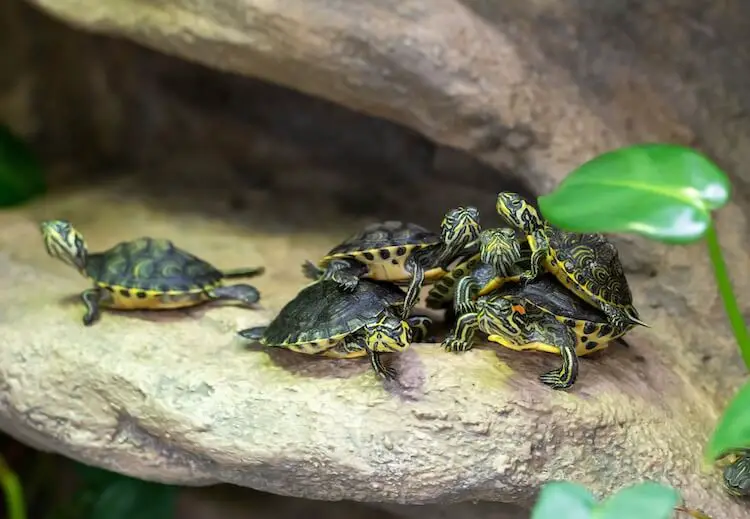
Baby red eared sliders need a proper and safe habitat to stay healthy and happy. Before getting a turtle make sure you can provide them with everything in the list below:
- Controlled Temperature: Baby red eared sliders are sensitive to sudden changes in temperature. Drops in temperature can cause pneumonia. Before adding your turtle to its tank, make sure the temperatures are holding steady in their normal range.
- Omnivorous Diet: Baby sliders eat vegetation, moths, earthworms, crustaceans, tadpoles, snails, and any other small animal they can catch in the wild. Their diet is not limited to one thing, so you should not feed them just one prey. A varied diet is both nutritionally and mentally enriching. It also helps them to get a full range of vitamins.
- Clean Water: Young red eared sliders need very clean water for swimming and drinking. Use an aquarium pump to circulate and filter tank water. You should also test the water once a week for ammonia, nitrite, and nitrate levels.
- Stress-Free Tank: Even if their tank setup is perfect, your baby red ear can still become stressed if the environment around the tank is too noisy or busy. Keep your turtle’s enclosure in a calm, quiet room that is out of the reach of dogs, cats, or small children. Your slider will spend much less time hiding and more time basking, swimming, and exploring if it feels safe in its surroundings.
- Tank mates: Sliders can share a tank with fish, but this adds some extra challenges for tank cleanliness and turtle health. Babies should generally not be kept with any fish larger than guppies. However, for first time keepers, we would avoid keeping tank mates.
3. Baby Red Eared Slider Tank Setup
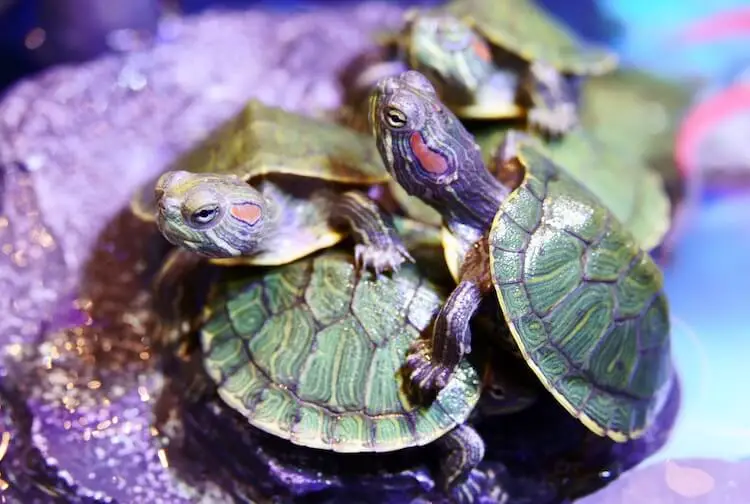
For every inch of your turtle’s shell length you will need to provide them with a minimum of 10 gallons of space. For adult sliders, this can mean purchasing a tank up to 120-gallons.
Because these turtles grow fast, you may want to consider buying an adult-sized tank to save money. While it may look strange to have a baby turtle in a 100+ gallon tank, your turtle will quickly grow to fill it.
Sliders are aquatic and need clean, chemical-free water to swim in.
Fill the tank with water at least twice as deep as your baby’s shell. Even as hatchlings, red eared sliders are excellent swimmers, you don’t need to worry about them drowning.
Though they love water, sliders also need land for basking and drying out.
The land area should cover no more than a third of the tank’s surface area. It should be large enough for your turtle to move around on.
Lighting
Baby red eared sliders bask in direct sunlight in the wild. As pets, this is usually not possible as glass or plastic tanks should never be placed in direct sunlight. Instead, heat and light bulbs are used to mimic sunlight.
Turtles need both UVB and UVA lighting to stay healthy and active.
Use an ultraviolet fluorescent bulb to provide your baby slider with plenty of UV light. The light source should be securely suspended 24 inches above your turtle’s basking platform. It should also not be blocked by plastic or glass as this will filter out the UV.
Baby sliders also need a heat bulb. This can be in the form of a ceramic heater or heat lamp, as long as it warms the air and basking spot.
They thrive in water and ambient air temperatures of between 75°F and 85°F. Basking temperatures on the surface of the basking spot should be 90 to 95°F.
Monitor water, surface, and air temperatures with a thermometer to keep your baby red eared slider healthy.
Why Is My Baby Red-Eared Slider Not Basking?
Baby sliders will not bask for two reasons:
- They can’t reach the basking platform.
- The water and air temperatures are not correct.
A basking platform needs to be easily accessible, stable, and dry. Use a gently sloping ramp from the water to the basking spot to help your turtle reach the platform.
Even if they can reach the basking spot, turtles will not bask if the water temperatures are too high and/or the air and basking temperatures are too low.
4. How To Care For Baby Red Eared Slider Turtles
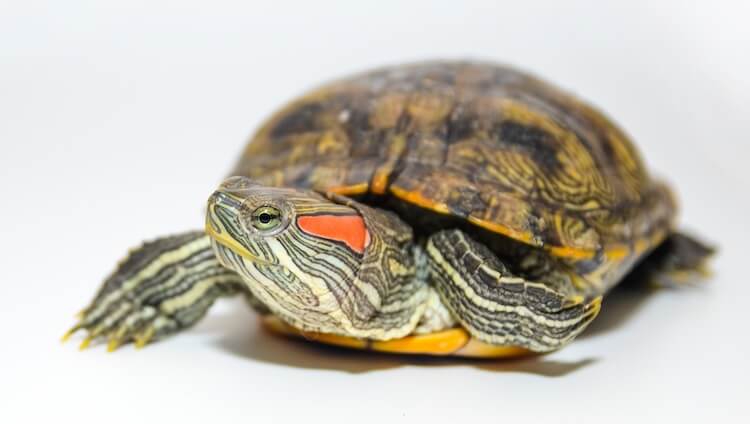
Caring for a baby red eared slider is different than caring for an adult slider.
Adult sliders are hardy, but babies are more susceptible to illnesses.
Young and older species will need a large tank (with land and water), an omnivorous diet (plant and meat) and warm temperatures. However, the immune systems of baby sliders are still immature. This makes them more sensitive to their environment.
Baby sliders need smaller temperature ranges, more frequent feeding and a very clean tank.
Frequent tank cleaning, consistent temperature checks, and a quality diet are the best ways to prevent a sick turtle. Creating a care schedule is a great idea for new turtle owners.
| Day | Activity |
|---|---|
| Monday | Feed, spot clean |
| Tuesday | Feed, spot clean and check temperatures |
| Wednesday | Feed, spot clean and handle turtle to check health |
| Thursday | Feed, spot clean |
| Friday | Feed, spot clean and check temperatures |
| Saturday | Feed, spot clean |
| Sunday | Feed, partial water change, check water quality |
Schedules are helpful for keeping up with cleaning, feeding, checking temperatures and water quality. Sticking to a schedule reduces stress and makes caring for your baby slider much easier. It also provides stability for your turtle.
The most important part of caring for a new slider is cleanliness.
Sliders create a lot of waste, mostly in their swimming area. If not cleaned properly, dirty water will increase the risk of illness, infections, and even sudden death. Water that looks clear may still be high in the toxic ammonia and nitrites caused by decaying food and waste.
To keep their tank clean scoop out any uneaten food or visible waste every day. Every week use a gravel vacuum to remove 25% of the tank’s water. This water should be replaced with fresh, treated water. Test the water weekly to monitor levels of nitrates, nitrites and ammonia. Ammonia and nitrites should be 0, while nitrates should be 40 parts per million or below.
Baby red eared sliders are known to get sick quickly. They are more likely to develop infections.
It helps to be able to spot any injuries or unusual behaviors early on. Their small size can make it difficult to spot injuries, but some common signs are:
- Lethargy
- Refusing to eat
- Dull eyes or shell
- Loose droppings
- Patches on the shell
You can also pay attention to your slider’s behavior. Knowing if your turtle is acting differently will help you catch health and husbandry issues before they become serious.
Before bringing home your baby slider, make sure you are prepared with the right setup and equipment.
It is best to have your slider’s tank up and running at least four weeks before bringing it home. This will let you cycle the tank and control temperature and filtration properly.
5. Baby Red Eared Slider Diet
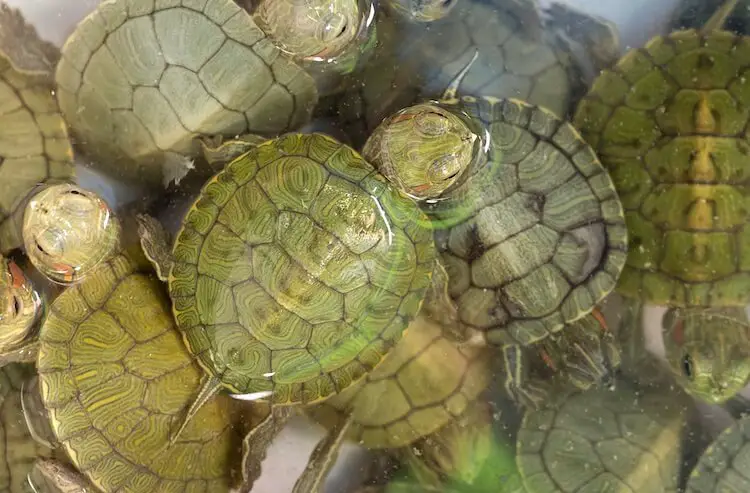
Baby red eared sliders are voracious eaters and should be fed every day.
A major difference between adult and baby red eared sliders is their diet:
- Adults eat primarily a 50/50 balance of plants to meat.
- Babies and juveniles need a 30/70 ratio of plants to meat.
One quarter of your baby slider’s protein content should come from commercial turtle food pellets. The rest should be made up of live or pre-killed animal prey. For plants, avoid water-based vegetables with low nutritional value (e.g. cucumbers, celery, and iceberg lettuce).
Here is a good list of high-protein and nutritious foods that are safe for a baby slider:
| Meat / Protein | Vegetables |
|---|---|
|
|
The key to a healthy diet is variety.
Rotate food items throughout the week to provide a full range of vitamins. This will also provide enrichment and keep your slider from getting bored.
Baby red eared sliders grow quickly and need to eat more often than adults.
Feed them a portion of food the size of their head. This will be around a full tablespoon for a four inch turtle. Feed them every day until they reach six months of age, after which you can then switch to feeding every other day.
To prevent choking make sure all food is cut into bite-sized pieces. A good rule of thumb is to make sure food pieces are no larger than the distance between their eyes.
They prefer to feed in the water rather than on land.
Feeding is simple, just drop their pellets and food in to the tank.
If you are feeding in the main tank then scoop out any uneaten food after 10 minutes.
Some keepers choose to feed their slider in a separate tank. This helps to avoid making the water dirty in the main tank.
6. Why Is My Red Eared Slider Turtle Not Eating?
It is very common for a baby red eared slider to refuse food during the first three days. This is due to the stress of being introduced to a new environment.
After four days most baby sliders will start eating again.
If your slider still isn’t eating after a week, or has suddenly stopped eating, the first things you should check is:
- Is the water clean?
- Are the lights on a consistent schedule?
- Is the tank in a quiet and safe area?
- Are the temperatures in the correct range?
If the tank setup is correct then move on to check your turtle’s food.
It may be that your slider simply doesn’t like the food you are offering. You can try feeding cooked chicken or beef heart to stimulate its appetite.
7. Is My Turtle Male or Female?
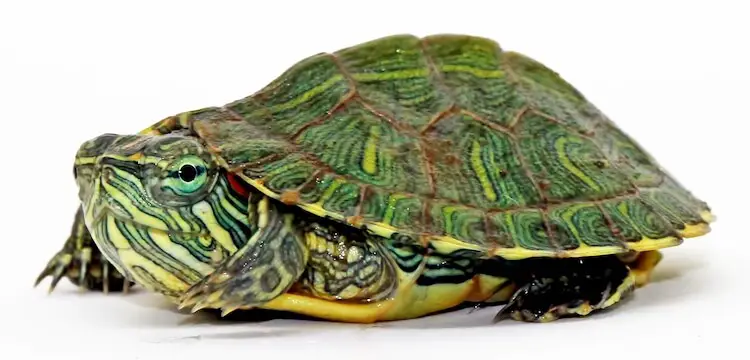
In very young turtles it can be difficult to accurately determine their gender.
Determining the gender of a baby red eared slider is usually more important to breeders. However, any turtle owner can become curious as to what sex their new turtle is. If you want to know whether your slider is a male or female, there are a few tips you can use.
- Females’ plastrons are flat (i.e. the bottom of the shell).
- Males’ plastrons are concave (i.e. curves in towards the spine).
- The vent of a female is closer to the edge of the shell.
- The vent of a male is farther down the tail, positioned away from the body.
- Males have a thicker, longer tail than females.
- The front claws of male sliders grow much longer than females’ claws. During courtship, males will wiggle their long claws in a female’s face to get her attention.
The differences between males and females will become more obvious as they age.
Once your red eared slider reaches two years old, if it is male, it will be fully mature and have all the typical male features. Females won’t mature until they reach five years of age. This is the same for yellow bellied sliders too.
It can be hard to sex a baby red eared slider based on physical characteristics.
The best and most accurate way for finding the gender of a turtle is asking the breeder what temperature the eggs were incubated at. The gender of the hatchlings is determined by the incubation temperature. Eggs incubated at 79°F will all hatch as males, while those incubated at 88°F will all hatch as females. If incubated in between, some will be male and some female.
8. Handling
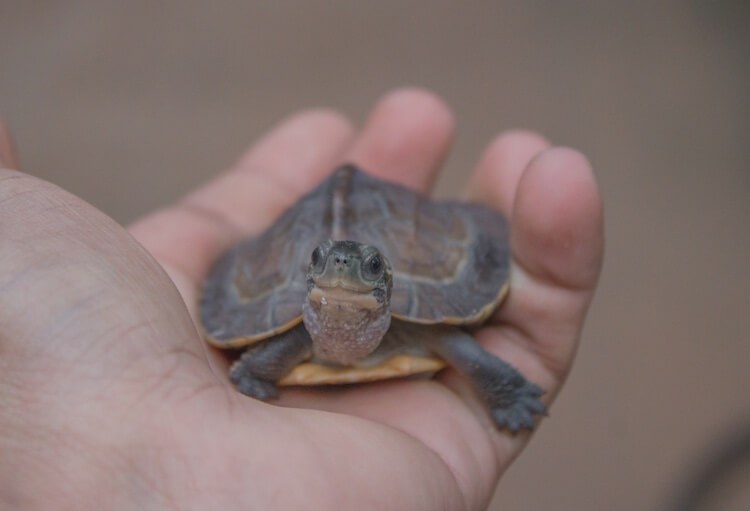
A red eared slider baby should be handled only when necessary. Turtles are usually not adaptable to being held, it can cause stress.
The best way to hold a baby red eared slider is to use your thumb and first finger on each hand in a pinching style. Have one hand on either side of the turtle and your thumbs on the bottom of the shell. Never squeeze your turtle or use more force than is necessary.
Limit the time you hold a baby red eared slider to five minutes.
Summary
There are few pets cuter than a baby red eared slider.
Remember that before buying this species, it should be over four inches in size. Buying or selling turtles smaller than four inches is against the law.
If you do decide to care for a baby red eared slider, keep in mind that they are sensitive to water quality and temperature. Clean your baby’s tank weekly to maintain pristine water conditions.
They thrive in water and ambient air temperatures of between 75°F and 85°F. Basking temperatures should be 90 to 95°F.
These turtles also need a varied diet of mostly protein to stay healthy. Feed them a portion of food the size of their head every day and rotate food items.
With the right care a baby red eared slider will keep you entertained for decades.
Let us know your best care tips below.

